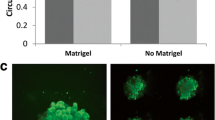Abstract
Several studies have shown that extracellular matrix reduces chemotherapeutic drugs-induced apoptosis in small cell lung cancer cells, myelomas and gliomas. We have investigated the protective effect of defined extracellular matrix components and of extracellular matrix from different cell types (fibroblasts, hepatocytes and intestinal epithelial cells) on the toxicity of three types of chemotherapeutic drugs on colon cancer cells. Human colon cancer cell lines LS174T and LiM6 were plated on plastic, on hepatocyte-derived ECM or on stromal ECM and in the presence of the antimetabolite 5-fluorouracil (5-FU), the topoisomerase I inhibitor camptothecin and the topoisomerase II inhibitor etoposide. We determined IC50 for the drugs for each of these culture conditions. We also determined the expression of the anti-apoptotic proteins bcl-2 and bcl-x (L) under these culture conditions. We found that stromal ECM protected LiM6 cells from the toxicity of etoposide and LS174T, but not LiM6 cells, from the toxicity of camptothecin. Collagen I, fibronectin and fibroblast-derived ECM rendered LiM6 cells, but not LS174T, more sensitive to the harmful effect of 5-FU. Both colon cell lines had increased expression of anti-apoptotic proteins bcl-2 and bcl-x(L) when cultured on the various ECMs and with the drugs, but there was no correlation between a protective ECM effect and expression of the anti-apoptotic proteins. Stromal-derived ECM may protect colon cancer cells from etoposide and camptothecin-induced apotosis, through a mechanism that is not bcl-2 or bcl-x(L) dependant.
Similar content being viewed by others
References
Sethi T, Rintoul RC, Moore SM et al. Extracellular matrix proteins protect small cell lung cancer against apoptosis: A mechanism for small cell lung cancer growth and drug resistance in vivo. Nat Med 1999; 5: 662–8.
Pullan S, Wilson J, Metcalfe A et al. Requirement of basement membrane for the suppression of programmed cell death in mammary epithelium. J Cell Sci 1996;109: 631–42.
Strater J, Wedding U, Barth T et al. Rapid onset of apoptosis in vitro follows disruption of beta 1-integrin/matrix interactions in human colonic crypt cells. Gastroenterology 1996; 110: 1776–984.
Taylor ST, Hickman JA, Dive C. Epigenetic determinants of resistance to etoposide regulation of Bcl-X(L) and Bax by tumor microenvironmental factors. J Natl Cancer Inst 2000; 92: 18–23.
Uhm JH, Dooley NP, Kyritsis A et al Vitronectin, a glioma-derived extracellular matrix protein, protects tumor cells from apoptotic death. Clin Cancer Res 1999; 5(6): 1587–94.
Damiano JS, Cress AE, Hazlehurst LA et al. Cell adhesion mediated drug resistance (CAM-DR): Role of integrins and resistance to apoptosis in human myeloma cell lines. Blood 1999; 93: 1658–67.
Bendall LJ, Makrynikola V, Hutchinson A et al. Stem cell factor enhances the adhesion of AML cells to fibronectin and augments fibronectin-mediated anti-apoptotic and proliferative signals. Leukemia 1999; 12: 1375–82.
Zvibel I, Brill S, Halpern Z et al. Hepatocyte extracellular matrix modulates expression of growth factors and growth factor receptors in human colon cancer cells. Exp Cell Res 1998; 245: 123–31.
Berry MN, Friend DJ. High-yield preparation of isolated rat liver parenchymal cells: A biochemical and fine structure study J Cell Biol 1969; 3: 506–20.
Nita ME, Nagawa H, Tominaga O et al. 5-Fluorouracil induces apoptosis in human colon cancer cell lines with modulation of Bcl-2 family proteins. Br J Cancer 1998; 78: 986–92.
Zhang Y, Fujita N, Tsuruo T. p21Waf1/Cip1 acts in synergy with bcl-2 to confer multidrug resistance in a camptothecin-selected human lung-cancer cell line. Int J Cancer 1999; 83(6): 790–97.
Zhang Z, Vuori K, Reed JC et al. The alpha 5 beta 1 integrin supports survival of cells on fibronectin and up-regulates Bcl-2 expression. Proc Natl Acad Sci USA 1995; 92: 6161–65.
Boudreau N, Sympson CJ, Werb Z et al. Suppression of ICE and apoptosis in mammary epithelial cells by extracellular matrix. Science 1995; 267: 891–3.
Hungerford JE, Compton MT, Matter Met al. Inhibition of pp125FAK in cultured fibroblasts results in apoptosis. J Cell Biol 1998; 135: 1383–90.
Frisch SM, Francis H. Disruption of epithelial cell-matrix interactions induces apoptosis. J Cell Biol 1994; 124: 619–26.
Frisch SM, Vuori K, Kelaita D et al. A role for Jun-N-terminal kinase in anoikis; suppression by bcl-2 and crmA. J Cell Biol 1996; 135: 1377–82.
Author information
Authors and Affiliations
Rights and permissions
About this article
Cite this article
Kouniavsky, G., Khaikin, M., Zvibel, I. et al. Stromal extracellular matrix reduces chemotherapy-induced apoptosis in colon cancer cell lines. Clin Exp Metastasis 19, 55–60 (2002). https://doi.org/10.1023/A:1013880326925
Issue Date:
DOI: https://doi.org/10.1023/A:1013880326925




